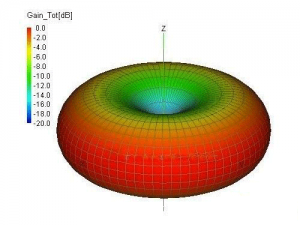Antennas exhibit varying radiation or receiving capabilities in different directions in space, which is known as the reactivity of the antenna. There are two types of antennas based on reactivity: omnidirectional and directional.
Omnidirectional Antenna
An omnidirectional antenna demonstrates uniform radiation at 360° on the horizontal pattern, commonly referred to as non-directional. Generally, the gain increases as the lobe width decreases. Omnidirectional antennas are typically used in communication systems with short distances, large coverage areas, and affordable prices. The gain is generally below 9dB. The figure below illustrates the signal radiation pattern of an omnidirectional antenna. (The radiation range of the omnidirectional antenna is similar to that of an apple.)

Directional Antenna
Directional antennas exhibit radiation within a specific angular range on the horizontal pattern, which is often referred to as having directivity. Similar to the omnidirectional antenna, the gain increases as the lobe width decreases. Directional antennas are commonly used in communication systems where the communication distance is long, the coverage area is small, the target density is high, and the frequency utilization rate is high.
From a gain perspective, there is no difference between the two antennas. However, there is an important distinction: the directional antenna is well shielded from interference signals due to its sharp pointing, which is crucial for evaluating the receiving effect. This is an important indicator. We can also understand the relationship between omnidirectional antennas and directional antennas in the following way: omnidirectional antennas transmit signals in all directions, allowing for reception from the front, back, left, and right. On the other hand, the directional antenna acts as a strong reflective surface behind it, blocking signals from the back and reflecting them to the front, thereby strengthening the signal in the front. (The main radiation range of the directional antenna is similar to an inverted, incomplete cone).

How to choose
Through the above analysis, we can visually recognize what is an omnidirectional antenna and what is a directional antenna. So what should be paid attention to in actual application?
If the antenna selection needs to meet multiple sites, and these sites are distributed in different directions of the AP, omnidirectional antennas are required; if they are concentrated in one direction, it is recommended to use directional antennas; in addition, consider whether the antenna joint form is compatible Whether the AP matching and antenna gain size meet your needs; the antenna installation For outdoor antennas, lightning protection equipment needs to be added between the antenna and the wireless AP; for directional antennas, pay attention to the front of the antenna facing the direction of the remote site; the antenna should be installed At the highest possible position, the line of sight between the antenna and the site is as high as possible (visible to the naked eye, avoid obstacles in the middle).

